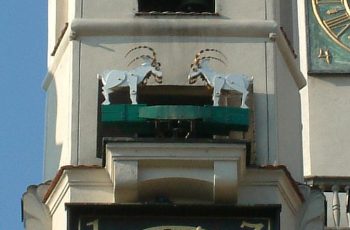The Museum of the History of the City of Poznan has been located in the Town Hall (the former seat of the municipal authorities) since 1954.
The beginnings of this building are dated to the early 14th century. Initially it was a small, one-story building, to which in the late 15th century one more storey was added. In the mid-16th century, the city authorities entrusted its reconstruction to the Italian architect Giovanni Battista Quadro from Lugano. Between 1550 and 1560 he transformed the modest Gothic town hall into an impressive, representative seat of the city authorities. The building was then extended to the west and raised to the second floor. The building acquired a uniform Renaissance external shape and a new interior layout with the magnificent Renaissance Hall, famous for its beautiful stucco decoration on the ceiling.
In the following centuries, the Town Hall tower underwent destruction and reconstruction several times.
Between 1781 and 1784, the entire building was renovated by the Good Order Commission; at that time a new classical helmet was built on the tower.
In 1910-1913, the town hall underwent another thorough conservation. This Prussian restoration saved the building from complete ruin. In 1945, due to wartime action, the tower collapsed and the second floor of the building was burned. The current appearance of the Town Hall is due to the conservation work that was completed in December 2000.
The black, topped with an attic, Renaissance-style Town Hall rises in a rectangular shape. The representative eastern façade opens to the market with a three-storey loggia, above which tower three polygonal turrets. The middle one houses a 16th-century clockwork with automata. Above the arches of the loggia are representations of virtues and geniuses, as well as Latin inscriptions referring to the dimension of justice. The line of the attic reveals a procession of Polish kings from the Jagiellonian dynasty. The blind side arches of the loggia contain representations of kings from the Piast dynasty.
The Poznań City History Museum exhibition, located in both the basement and on the ground floor and in the halls of the Town Hall on the first and second floor, will show the history of the city from the 10th century to the present day and the history of the Town Hall. Among the most valuable exhibits are a gilded and enamelled Limoges pastoral from the 13th century, a table clock with the Poznań emblem made in 1575 by the Poznań watchmaker Jan Stall for the local authorities and a goblet of the shoemakers guild from 1651. The Museum collections are constantly being expanded with additional objects, which are accepted as donations and acquired through purchases. The common denominator of them all is, of course, Poznań: the history of the city and its inhabitants. Due to the specificity of these objects, they have been divided into collections:
- Collection of Views and City Plans
- Collection of photographs of people
- Collection of historical documents and memorabilia
- Collection of Crafts and Everyday Objects
- Collection of Local Entrepreneurship
- Art Collection
- Collection of Cameras and Photography Equipment
- Collection of the Greater Poland Shooting Brotherhoods
- The Photography Collection of Jerzy Unierzyski
- Archaeological Antiquities Collection.
Thanks to such varied and numerous collections, the Museum of the History of the City of Poznań organizes temporary exhibitions, which in terms of their topics cover all areas of the city’s life. Among the popular exhibition series are, among others, Streets and alleys of old Poznań and Poznań families. This is not, however, the only area of activity of the Museum. Its employees are expanding and sharing knowledge about the history of the city, the City Hall and the Museum itself, as evidenced by various publications published by the National Museum in Poznań, but also outside of it.
The Poznan City History Museum also operates on Facebook: https://www.facebook.com/MuzeumHistoriiMiastaPoznania








